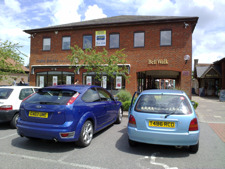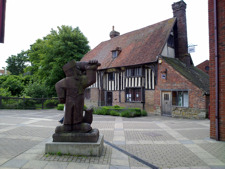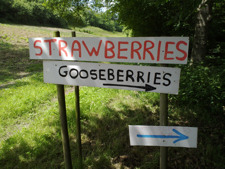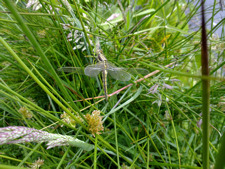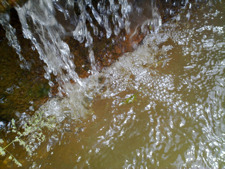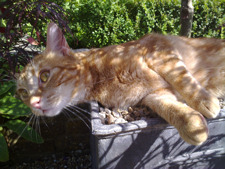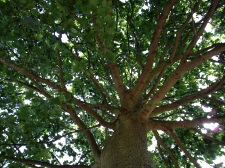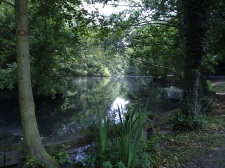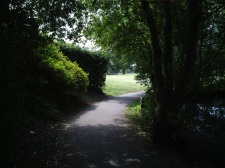Review: Nokia N86 8MP Review - Part 2 - The Camera/Camcorder
Part 2 of our extended review - see also Nokia N86 8MP Review - Part 1 - Overview
The story so far
As Rafe waxed so eloquently in Part 1 of this review, the Nokia N86 fits somewhere near the end of the line of Nseries dual-sliders, in many ways a spiritual successor to the all-conquering N95, which itself is still one of the top smartphones in the world. It also follows nicely on from the rather more niche N93 and N82, both heavily-pitched towards photography. The real question is: how much better is the N86 than its two year old (at least) camera-centric competition? And how well do all the much-hyped camera improvements work in real life?
Taking photos
This, above all else, is the main selling point of the N86 8MP. If taking ad-hoc photos of the world around you is something that you're passionate about then you're going to love the N86. If you've been frustrated by bad indoor photos taken with other camera-toting phones, then again you're going to love the N86, which is markedly better in this scenario.
Here (and quoting bits where necessary from our original N86 overview) are the main improvements made on the camera front:
- There's a Tessar Carl Zeiss lens in the camera, as usual for Nokia's top phones, but here it's rated at a resolution of 8 Megapixels (3264 x 2448).
- The sensitivity of the sensor has been increased, relative to the already good N95/N82's sensor (physical size is similar, we believe). This means that it is able to more efficiently capture incoming light. This gives the sensor much more 'information' to work with and consequently results in higher resolution and potentially higher quality pictures.
- The N86 boasts a variable aperture, which means the size of the aperture (optical diameter) can be varied. The N86 has three settings: F2.4, F3.2 and F4.8, other phones typically have a fixed aperture (Nokia's are generally at F2.8). Varying the size of the aperture means that the amount of light let into the sensor can be changed. Higher F numbers mean a smaller opening and, as well as letting in less light, this can theoretically give sharper images. The overall effect of this is that, in theory, the N86 can produce higher quality photos over a greater range of lighting conditions. While the most noticeable difference will be in low light conditions (where camera phones typically struggle), the N86 also takes slightly better photos in very sunny conditions (sharper).
- In addition to the usual Nseries mechanical shutter, Nokia have also included software that does 'Automatic Motion Blur Reduction' and routines for producing higher 'dynamic range' (detail in both very dark and light areas). Going hand in hand with these are improvements to the camera software performance; camera start up time, shutter lag and shot-to-shot times have all been improved.
- There's also a wide angle lens (28mm) lens. This means that the N86 will capture a greater area compared to a standard lens. In captured images (and videos), you'll see extra material on the left, right, top and bottom of images.
Here are half a dozen photo samples from Rafe: (See also Rafe's detailed head to head between the N86 and the N82, N97 and INNOV8)
(Click through for source images)
And a few of mine:
In view of the improvements made to the camera hardware (compared to the run-of-the-mill 5 megapixel Nokia camera unit), I wanted to go further though, to hopefully demonstrate just how much better the N86 8MP is, i.e. beyond the simple increase in pixel resolution. In the comparison photos below, except where noted, I was using the well known Nokia N95 'Classic' as my yardstick - the N95 is still just about as good as a phone camera gets, with mature software now and with mechanical camera glass protection (so no chance of scratches or fingerprints distorting the results).
Fading light details

As you can see, the sun was just about to set, light levels were low-ish AND I was shooting into the source of light. How well could the N86's 8mp sensor pick out the detail on the car number plate?

Significantly better, as you might expect. The N95's photo (top) seems to indicate that the second character shown is '5', rather then '6', the real number.
Garden greenery at dusk
The light levels here were really very low, much darker than the photos make out. The sun was just setting (taken just after the test shot above), this corner of the garden was in 'shade' anyway, and the N86 (and N95) both wanted to use their flash to help out. I said 'no' because this is a test of the extra sensitivity and aperture size on the newer phone.

Again, zooming right into the centre of the photo, we can see the differences in captured detail under these light conditions:

As you can clearly see, the N86's photo (bottom) is crisp, with accurate colours (there's no pink/orange stone in real life) and better focus and detail. Quite a stunning difference in fact. Remember, I'm really pushing the N86 here, and remember that I'm comparing it to one of Nokia's previously very best camera phones.
Shiny, shiny
One of the boasts of the N86 is that it can vary its aperture size. Both to cope with low light and, perhaps more importantly, to cope with very bright light, by 'stopping' down the aperture to stop the light over-saturating the sensor.

Three objects, varying colours and reflectivity, placed in the full sun on a black trampoline. The N86's version (bottom) of the photos was significantly less bleached out than the N95's - let's look at some detail:

You can see that the reflection of the sun on the orange has been far better controlled on the bottom N86 photo, allowing more detail to be seen. The texture of the trampoline is also much clearer, hinting at better depth of field (another benefit of reducing the aperture size in bright light).
Flash in the fan
What about the six million dollar question. Can the N86's dual LED flash and better sensor make up for not having a Xenon flash, this being an 'ultimate' camera phone? Here's the test - a fan turned on, about 2 metres away, in a pitch dark hallway. This is your classic 'photos at a club/disco' scenario, in terms of trying to illuminate and capture a moment. In each case, I've cropped the central part of each photo, so that you can see detail better.
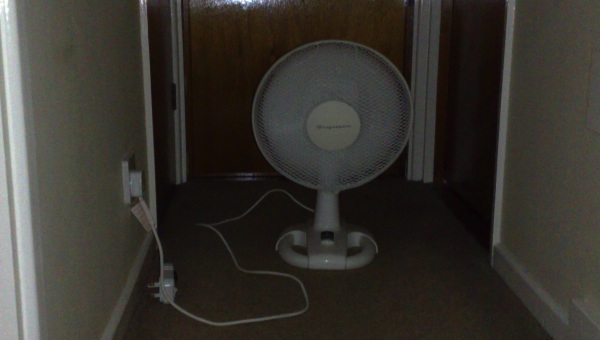
Nokia N95 (single LED)
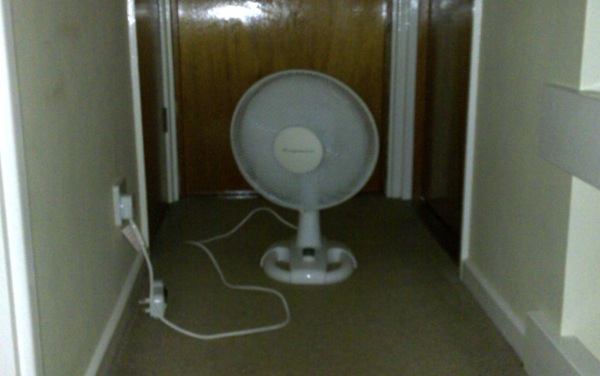
Nokia N96 (dual LED)
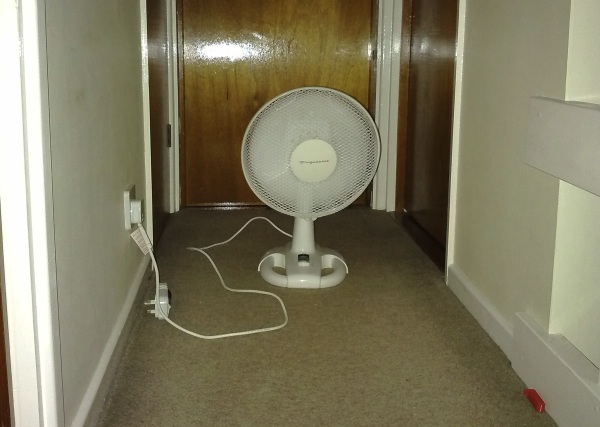
Nokia N86 (dual LED, bigger sensor, wider aperture)
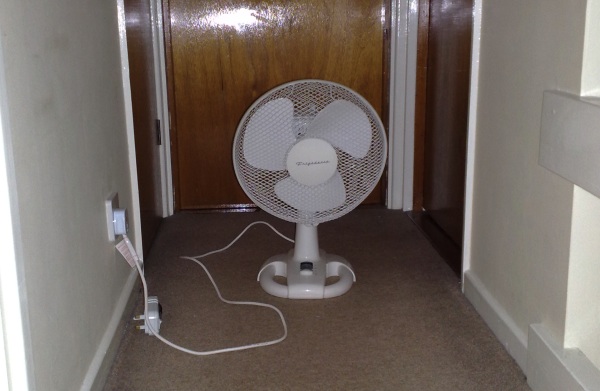
Nokia 6220c (Xenon flash, cheapish sensor)
As expected, the Xenon flash-lit shot freezes the fan blades perfectly - this is one of the two great advantages of Xenon. HOWEVER, the second big advantage is illumination, but from the evidence above I'd say that the dual LED flash of the N86, coupled with the bigger, better sensor and wider aperture, produces a scene that's lit just as well as the Xenon version.
Have I forgiven Nokia for NOT putting a Xenon flash in the N86? Almost. 8-)
See also Rafe's head-to-head shots between Nokia N86 and: N82, Samsung INNOV8 and N97.
Camera modes
The Camera application has the usual assembly of settings, including a customisable toolbar and geo-tagging, but the new highlight is the panorama mode. This functionality, a result of Nokia's acquisition of bitSide, automatically stiches images together to produce a wide panoramic image. A bit gimmicky? Maybe, but it does manage to produce some decent looking results. Essentially, you snap one photo and then start panning the N86 round. When the software detects that the 'next' photo is needed, it takes it automatically - you just need to keep moving round.
The captured angle is approximately 180 degrees and seems preset at five photos, end to end - although presumably you could do two panorama shots and then stitch them together on your desktop to produce a full 360 degrees. Still, I'd like to see Nokia extend the function to (optionally) take more photos in a sequence.
The final images are about 5000 x 900 pixels (although the exact dimensions depend on how smoothly and accurately you swivel to keep the panorama guides aligned properly on-screen. Here are three examples of the output, the individual photos are aligned automatically and their edges blended - if you look really closely then you can spot the joins, but they'll pass casual muster:
Click through for source images
The Camera interface is otherwise similar to that on other previous Nokia S60 phones, but the creators obviously realised that with 'Panorama' and 'Go to Photos' now added to the existing 'toolbar', the latter was beginning to look unworkably unwieldy. So it has been drastically simplified, by default, with brightness, Colour tone, Contrast, Exposure, Light sensitivity, Sharpness and White balance all relegated to toolbar shortcuts that can be 'added' later if needed. This approach works well and 99% of use cases won't need any manually fiddling. I did find that 'Exposure' was handy to put back on the toolbar, for either taking silhouettes or trying to salvage detail against a bright sky.
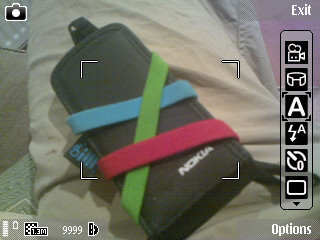
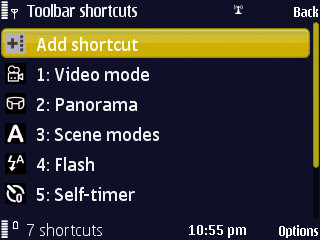
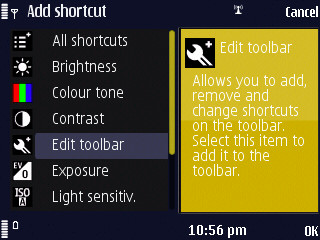
Automatic Motion Blur Reduction (AMBR)
AMBR is an innovation for Nokia's cameras and works by analysing the movement in the viewfinder image. It's looking for either subject movement or camera movement. If it detects either it will appropriately increase the shutter speed (i.e. open it for a shorter time) to minimise/eliminate either a blurred subject, camera movement or both. This is mainly made possible by the increased sensitivity of the sensor - i.e. there's light to spare and the shutter speed can be reduced in many situations and still leave plenty of light with which to compose the photo.
Whilst different to image stabilisation (IS) systems, AMBR can give more pleasing results. IS systems only compensate for camera movement and not subject movement - you're still left with slow shutter speeds. Whilst you may have less noise with a IS system because it is using slower shutter speed and relying less on the sensor, a blurred subject is far from ideal, of course, and this is where AMBR can be better. It also has a benefit over some digital IS systems which can't work with flash as they require multiple frames to create a single clearer one.
Testing AMBR is tricky because it's a feature that it always 'on' - so the N86's photos are benefitting from this all the time without you being aware of it. In practice, AMBR just means that your success rate with photos will be higher, with less camera shake problems and less blurring on human subjects who just can't stand still. Under extreme conditions, e.g. with dancing or running subjects, AMBR falls down and won't produce any benefits - it's arguably a marginal technology, but from the fact that you can't turn it off, Nokia seem confident in it and so is probably better to have than not have!
Video capture
Video capture on the original Nokia N95 was stunning for its time, taking the market leading VGA capture (at 30fps) of the niche N93 and putting it in a much more standard, mass-market form factor (albeit at the loss of the forward facing stereo microphones and optical zoom). The N95 8GB and N82 inherited the same camera and set up Nokia's reputation as the best video capture phones in the world. Unfortunately, the N79, N85, N96 and N97 all featured a different, smaller camera that was limited, pre-focussed, in video mode, on infinity, making them not suitable for close-up videos of family and friends, all of whom would appear somewhat blurred.
The N86 8MP has, thankfully, a camera along the lines of the original N95's with a mechanism for pre-focussing in video mode, set at around a metre or two. In good light, this means a depth of field that extends backwards towards the horizon and gives the best of all worlds. In addition, the N86 even improves on the N95 itself, by being the first camera phone in the world not to 'bin' pixels when capturing video. In other words, every last pixel from the 8mp sensor is used in gathering data to create the VGA video picture and the end result is clearer than before and with better low-light performance.
You can see the clarity of video from the N86 here in a test video shot in bright but overcast conditions early in the morning. A snippet from the N95 is also included. Note also that the audio is as clear and is of as high quality as we've come to expect from Nokia's Nseries.
(Click to download or play)
Note also the wide angle lens on the N86, which has even more of an effect in video mode than in still photo mode - with the pre-focus, with the wide angle and with the more sensitive sensor, you should be able to film almost anything and get reasonable footage. Here's some footage from a pitch dark room:
Click to download or play
Admittedly I haven't tested night video capture on the N79, N85, N96 and N97 exhaustively, but from what I've seen anecdotally, this quality footage, while not perfect, is an order of magnitude better than that on the other devices with their smaller apertures and smaller, less sensitive sensors. There's still the issue of dazzling your subjects with the dual LED right next to the lens, and of course, even the N86's sensor won't be able to help if you're trying to film something more than a metre or two away in the dark.
Also of special note is that digital zoom becomes possible for real - because the whole sensor is used for video capture, up to 4x zoom is handled without undue pixellation. See here for a demo. The system works surprisingly well - in low light, it's even superior to optical zoom, since the latter involved more glass optics, reducing the light that gets to the sensor. Nokia don't push this improved zoom facility in their marketing, but it's something well worth noting.
With a gap of two years since the N95, you might have expected Nokia to have progressed beyond VGA capture, but this is something of a technological sweet spot. If you increase resolution further then you start increasing the file sizes of movies way beyond the current 20MB/min, requiring more and more storage to save files and requiring more and more processor power to encode and manage them. As we've seen with the Samsung i8910 HD, it's easy to mess up in this area (frame rate drops, audio problems), but I would expect to see Nokia announce a phone with 720p (HD) recording at some point, possibly MWC next year, when the electronics, processor power and storage equations have all been solved.
In the next and final part of my Nokia N86 review, I'm going to look at its multimedia handling, at its application set and then deliver my verdict.
Steve Litchfield, All About Symbian, 28 June 2009
Reviewed by Steve Litchfield at

